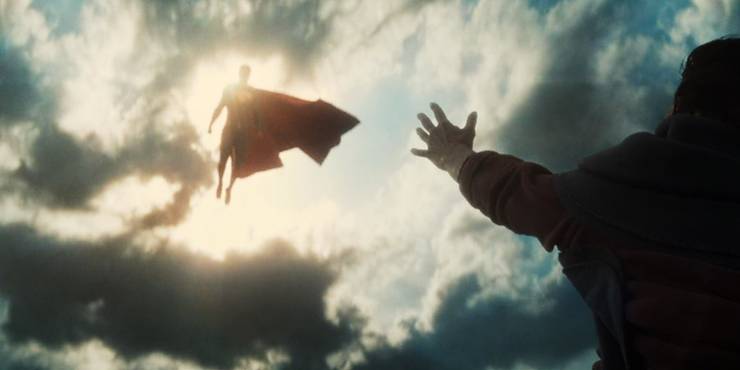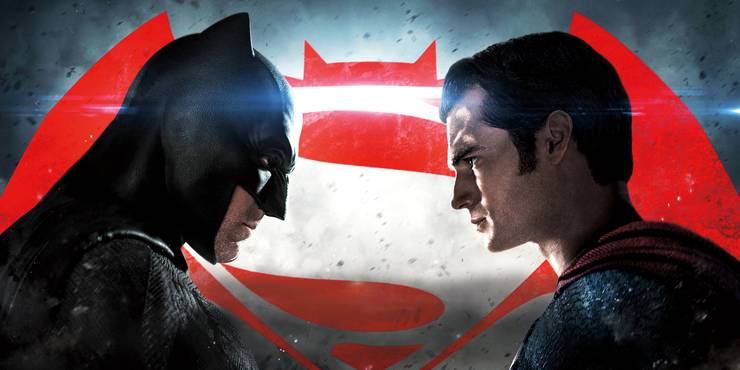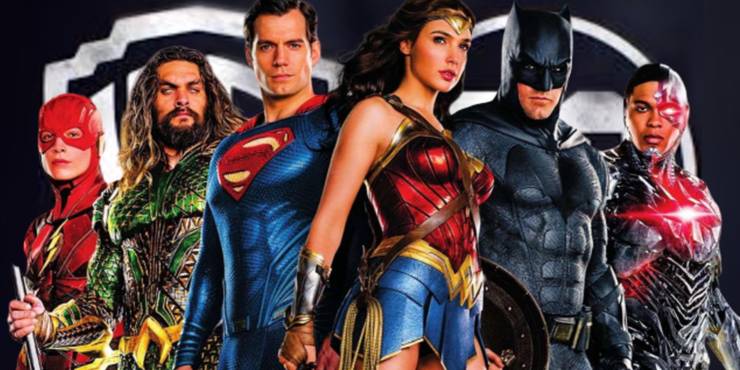Batman v Superman: Dawn of Justice is officially four years old, and in that time it’s become clear it’s the most important superhero movie ever. Most people are shocked it’s four years old, some because it seems like it just came out last year, others because it seems like a decade ago, which is fairly in-line with the movie’s general reception. There is only hot or cold with perspectives on Batman or Superman, and that’s as true today as it was the day it hit theaters.
The behind the scenes drama and the total disaster of Justice League accompanied by Affleck leaving the role of Batman and Cavill’s future as Superman being perpetually up in the air and incessant demands for the Snyder Cut have certainly kept it in the conversation this whole time, but it’s not only fans who bring it up. Even its biggest haters, four years later, are still talking about it.
There may never be any agreement on whether or not Batman v Superman: Dawn of Justice is a good movie or a bad movie, but the mere fact that this debate will continue in perpetuity makes it one of the most important superhero movie to ever hit the big screen.

When Lois Lane goes to interview an African warlord (and self-professed freedom fighter) in a conflict where the United States has pledged neutrality, she finds herself suddenly caught in the middle of a shadow operation by US special forces and mercenaries secretly hired by Lex Luthor. Superman saves the day, but the US government won’t acknowledge its involvement in the region, leaving all the blame on Superman for the destabilization of the region.
Superman is unchecked power, not liable to any government or other authority, but he’s an American, making the government concerned about his lack of oversight. Lex Luthor stokes these fears in both the government and Bruce Wayne, who lost a building with friends and employees during Superman’s fight against Zod in Man of Steel, and Bruce is convinced Superman represents a threat to the world – or could be if he isn’t taken out first.
Luthor uses these fears to drive Batman and Superman to a head to head conflict, which is only narrowly averted by Batman discovering his common humanity with Superman. The two heroes team up, but it’s too late, as Luthor has unleashed a reborn General Zod as a Kryptonian Monstrosity Doomsday. Wonder Woman joins Batman and Superman and Superman sacrifices himself to kill Doomsday, inspiring Batman to rise from his broken and brutal ways knowing mankind can be better and rebuild.
On a high level, it’s impossible to ignore the relevant political and societal questions from foreign governmental interventions to billionaires posing as philanthropists while pulling strings with the government and others to work against societies best interests to themes of xenophobia or even more personal struggles such as grappling with loss and seeking belonging as an outsider. Even breaking the movie down minute by minute, it’s packed to the brim.
While comic book movies always strive to strike on some sort of social relevance, nothing hits the zeitgeist on the head as strongly as Batman v Superman: Dawn of Justice, to its benefit or detriment. Many detractors have claimed these issues are actually a problem with the movie, as its ambition was greater than Zack Snyder’s ability to execute, and while that argument isn’t likely to be solved soon, its mere persistence speaks volumes as the movie is still a major point of discussion so long after its debut as many other higher grossing and better-reviewed superhero movies have come and gone.
Batman v Superman Challenges Viewers Perceptions of Characters

Batman v Superman: Dawn of Justice doesn’t only tackle tough contemporary topics, but also their titular characters, in a way that challenges viewers. Zack Snyder has been accused of failing to understand Batman and Superman time and time and again by BvS’s detractors, but the fact that he’s capable of getting such a visceral response to his interpretation in the first place indicates he knows exactly what makes these characters tick and made a movie that challenged their ideals to the core.
Criticisms against Snyder’s interpretation of Batman and Superman focus on core tenets of the characters like Superman’s hope and optimism and Batman’s no-kill rule. But these characters are, and always have been, defined by their struggles with these ideals, not their ability to exhibit them no matter what. Batman’s legendary “one rule,” for example, doesn’t exist as a constraint on Batman storytelling, but to give Batman a personal line to struggle with. Even in Christopher Nolan’s The Dark Knight, largely considered the best Batman movie, tackles this concept as Joker makes it his mission to force Batman to violate his “one rule.” While audiences focus on the fact that Batman doesn’t kill the Joker, they miss that Joker’s plan wasn’t for Batman to kill him, it’s the fallen Harvey Dent, corrupted by Joker into Two-Face, that Batman is ultimately forced to kill – and he does – “because he’s the hero Gotham deserves, but not the one it needs right now.”
The fact that Batman kills – in any story – doesn’t defeat the purpose of the character. At the core of Nolan’s Batman movies is the theme of “why do we fall? So we can learn to pick ourselves back up.” Keeping with that theme, in Batman v Superman, Batman is fallen, only this Batman doesn’t know how to pick himself back up because he’s lost hope. In his words from the movie’s opening, “what falls is fallen.” It takes Superman to give him that inspiration and hope he needs to come back from that fallen place, thereby also proving Snyder’s Superman is capable of that kind of inspiration, even though he struggles to find his place in the world along the way.
Yes, Superman doubts himself and Batman breaks his one rule. These things don’t happen because Zack Snyder and Chris Terrio forgot or misunderstood what typically defines these characters, but because they knew exactly what kind of struggles define Batman as Batman and Superman as Superman: Batman’s drive for justice and struggle with succumbing to his more brutal drive for revenge and Superman’s capacity for inspiration despite the fact that he’s an alien who doesn’t seem to belong. Their character journeys aren’t defined by exhibiting those characteristics, but by seeking and discovering (or rediscovering) them along the way.
The Lasting Impact of Batman v Superman: Dawn of Justice

Since 2016, many superhero movies featuring well-known characters have come and gone. There have been 33 comic book movies in and out of theaters since Batman v Superman: Dawn of Justice, including 12 MCU movies, eight DC movies, four X-Men movies, and eight from other franchises. On average, these movies were better reviewed than Batman v Superman, and nine of them outperformed BvS at the box office. Yet in 2020, it’s BvS that is still being debated.
The fact that the movie still frequently spawns debates over what Batman or Superman should be or whether or not it’s ok for Batman to kill or what it means for Superman to be inspiring is the point. These are questions we should be asking of all characters, and Batman v Superman doesn’t only ask them, but it still has people challenging those topics four years later.
Batman v Superman: Dawn of Justice developed a strong following, so some may try to ascribe any continued conversations to the many passionate fans who continue to carry a torch for the movie, and while that certainly has an impact, it’s far from the whole story. BvS is still treated as a benchmark by many detractors by which they compare other movies seen as a failure even though there are plenty of examples of comic book movies most would agree are worse, such as Green Lantern, Batman & Robin, Daredevil, Dark Phoenix, X-Men Origins: Wolverine, or Fantastic Four.
The reason Batman v Superman: Dawn of Justice is still talked about is because, despite its poor reviews, it struck a chord few other superhero movies successfully hit. Even Batman & Robin, which was so offensively bad it killed the Batman movie brand for nearly a decade, doesn’t get as much attention. Meanwhile, Batman v Superman, despite the split reception, is still experiencing a re-evaluation four years later.
Zack Snyder’s director’s cut, referred to as the Ultimate Edition of the movie, is frequently cited by former detractors who have come around on the film, and as Zack Snyder’s full five-part intended vision continues to become understood (despite his version of Justice League not yet seeing the light of day), more people continue to look back on Batman v Superman and see a movie that truly stands apart from the rest of the genre and does something unique. In the same way, consensus on his similarly polarizing Watchmen has come around in recent years, so too has the opinion on his Batman v Superman: Dawn of Justice (with both shifts largely credited to each movie’s respective director’s cut).
Then, of course, there’s the Snyder Cut, or Zack Snyder’s Justice League as he’s calling it now. The cries for this version of the film have only grown louder since the release of Joss Whedon’s heavily rewritten and reshot theatrical cut of Justice League, and while that movie has its own legacy, the conversation can’t take place without Batman v Superman, since Justice League was supposed to be a direct continuation of BvS, and the sequel elements were some of the most heavily altered. If it weren’t for the passionate reception to Batman v Superman, and the drive (or simple curiosity) to see how that story was supposed to continue, there would be no demand for the Snyder Cut.
While it’s looking like eventually Zack Snyder’s Justice League will be realized in some form, the odds of his full vision being fully realized are still up in the air, making Batman v Superman: Dawn of Justice that much more of a legend and securing its place as a part of the pop culture zeitgeist for years to come.
About The Author




